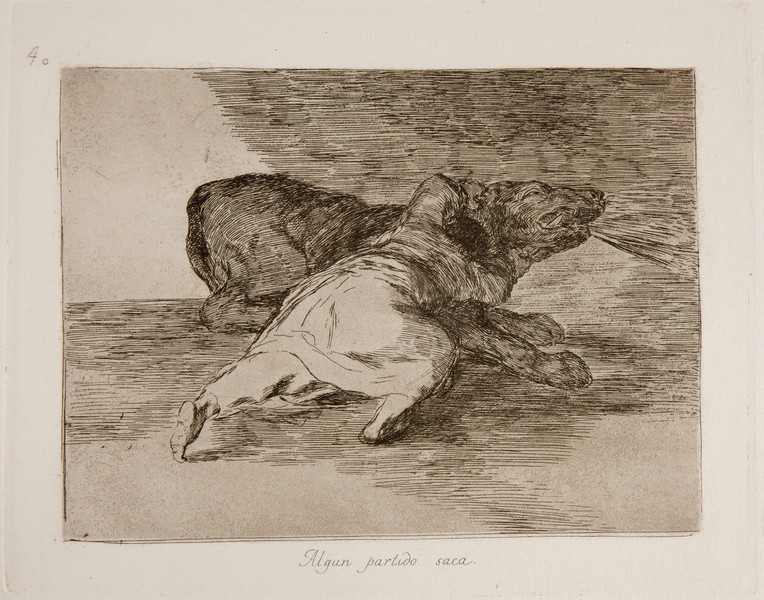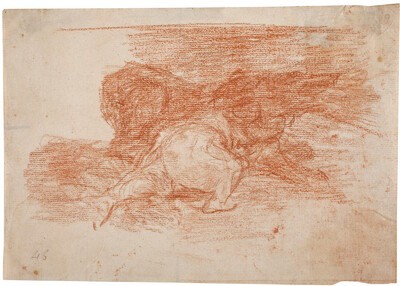- Cronología
- Ca. 1814 - 1815
- Dimensiones
- 177 x 221 mm
- Técnica y soporte
- Aguafuerte, punta seca y buril
- Reconocimiento de la autoría de Goya
- Undisputed work
- Ficha: realización/revisión
- 13 Dec 2010 / 24 May 2023
- Inventario
- 225
See Sad presentiments of what must come to pass (Tristes presentimientos de lo que ha de acontecer).
The second artist's proof shows that the left-hand side of the figure's waist and their left foot have been shaded in with drypoint. We can also see an area of drypoint that extends from the right ankle to the lower part of the figure's clothing, while there is diagonal shading executed in burin on the floor next to the figure's right leg. The contour of the knee has been altered slightly, and the upper part of the animal's right foreleg is shaded in to suggest the shadows.
The title was handwritten on the print by Goya in the first and only series that is known to have been printed at the time the works were created, which the artist gave to his friend Agustín Ceán Bermúdez. Therefore, the title was etched into the plate at a later date and left unchanged as of the first edition of the Disasters of War printed by the San Fernando Royal Academy of Fine Arts in Madrid in 1863, after the printing of the series in the possession of Ceán Bermúdez.
There is a surviving preparatory drawing for this print which is housed in the Prado Museum.
A figure is shown attacking an unidentifiable animal in a physical altercation. The figure grasps the animal by the neck and stabs it with a knife, forcing it down onto one side.
There is no spatial reference in the print that would give a clue as to the time or place when the scene is unfolding. The light enters from the upper left-hand corner of the composition, also lighting up the lower section of the animal and figure embroiled in a ferocious struggle, while the rest of the scene is left in the shadows.
In this print Goya creates a pause, giving the viewer a moment's rest following the long series of atrocities, violent and abominable acts that he has unfolded before our eyes. It is as if with this image he wishes to close a parenthesis that begins with print no. 2 in the series, With or without reason (Con razón o sin ella).
The animal that features in this work is likely to have a symbolic significance, establishing a relationship between He gets something out of it and the Emphatic Caprices (Caprichos enfáticos) that bring this series to a close. Indeed, there are some clear similarities between the beast shown in this print and that featured in no. 81, Fierce monster (Fiero monstruo). Various readings have been made of this image. Juan Carrete and Jesusa Vega believe that the animal in the image might be a bulldog, an allusion to the English army that took part in the Spanish War of Independence as Spain's ally. The English abused the local population, taking advantage of their participation in the war to plunder and wreak unnecessary destruction. Enrique Lafuente Ferrari claims that this image is an allegory of the Spanish population fighting a battle with the French on unequal terms, in the same way as this figure takes on a robust animal. Despite this inequality, the Spanish army manages to get something out of the fight, as the title suggests.
The plate is stored in the National Chalcography (cat. 291).
-
Goya and his timesThe Royal Academy of ArtsLondon1963cat. 66cat. 245
-
Francisco de GoyaMuseo d'Arte ModernaLugano1996exhibition celebrated from September 22nd to November 17th.cat. 40
-
Francisco Goya. Sein leben im spiegel der graphik. Fuendetodos 1746-1828 Bordeaux. 1746-1996Galerie KornfeldBern1996from November 21st 1996 to January 1997cat. 153
-
Francisco Goya. Capricci, follie e disastri della guerraSan Donato Milanese2000Opere grafiche della Fondazione Antonio Mazzottacat. 120
-
Goya. Opera graficaPinacoteca del Castello di San GiorgioLegnano2006exhibition celebrated from December 16th 2006 to April 1st 2007p. 71
-
Goya et la modernitéPinacothèque de ParisParís2013from October 11st 2013 to March 16th 2014cat. 79
-
Goya, grabadorMadridBlass S.A.1918cat. 142
-
Goya engravings and lithographs, vol. I y II.OxfordBruno Cassirer1964cat. 160
-
Vie et ouvre de Francisco de GoyaParísOffice du livre1970cat. 1056
-
Catálogo de las estampas de Goya en la Biblioteca NacionalMadridMinisterio de Educación y Cultura, Biblioteca Nacional1996cat. 246
-
ParísPinacoteca de París2013p. 139
-
Goya. In the Norton Simon MuseumPasadenaNorton Simon Museum2016pp. 114-151

